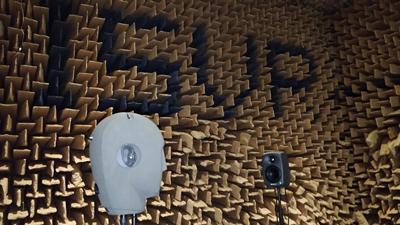Research project: Compact-Mode HRTFs
We are developing a new representation of a HRTF that is more compact, leading to sparser HRTF measurement rigs, smaller HRTF datasets and more efficient binaural rendering.
We are developing a new representation of a HRTF that is more compact, leading to sparser HRTF measurement rigs, smaller HRTF datasets and more efficient binaural rendering.

Head-Related Transfer Functions (HRTFs) are widely used in 3D audio, allowing Binaural rendering of audio material. HRTFs are often measured in an anechoic chamber, generally requiring the measurement of a source positioned at several hundred or even thousands of points around the listener (for an individualised measurement) or binaural mannequin microphone (for a generic HRTF measurement). This spatial representation of the HRTF may be transformed into the spherical harmonic domain, which provides an advantageous form of the HRTF for use in applications such as Binaural rendering of Ambisonics. However, to achieve this spherical harmonic transform many measurement points are required initially. For an accurate representation of the HRTF across the audible frequency spectrum, this can be as large as over 961 measurement points. This leads to increased costs with respect to acquisition, storage, transmission and rendering of the HRTF.
We are developing a new sparse representation of a HRTF using spherical harmonics, titled the ‘Compact-Mode HRTF’. This is achieved using simple rotations to reorder the energy of the HRTF into a few select spherical harmonics, then discarding those spherical harmonics with little energy and therefore little information. This means the Compact-Mode HRTF requires significantly less measurement points, smaller datasets and less channels during rendering than the traditional HRTF representation using all spherical harmonics.
The goal of this project is to not only develop this representation, but also utilise its advantages by creating a compact HRTF measurement rig in our anechoic chamber. This personalised HRTF may then be used in our custom binaural rendering software, powered by the VISR (Versatile Interactive Scene Renderer) Framework.
